Hemodynamic Monitoring System Market
Hemodynamic Monitoring System Market Size and Share Forecast Outlook 2025 to 2035
Hemodynamic monitoring system market is projected to grow from USD 1.7 billion in 2025 to USD 3.0 billion by 2035, at a CAGR of 6.0%. Minimally Invasive will dominate with a 42.0% market share, while hospitals will lead the end use segment with a 61.0% share.
Hemodynamic Monitoring System Market Forecast and Outlook 2025 to 2035
The global hemodynamic monitoring system market is projected to reach USD 3.0 billion by 2035, recording an absolute increase of USD 1.3 billion over the forecast period. The market is valued at USD 1.7 billion in 2025 and is set to rise at a CAGR of 6.0% during the assessment period.
The market size is expected to grow by approximately 1.8 times during the same period, supported by increasing demand for advanced cardiovascular monitoring technologies worldwide, driving demand for minimally invasive monitoring solutions and increasing investments in hospital infrastructure and critical care facilities globally. The high device costs and complex regulatory approval procedures may pose challenges to market expansion.
Quick Stats for Hemodynamic Monitoring System Market
- Hemodynamic Monitoring System Market Value (2025): USD 1.7 billion
- Hemodynamic Monitoring System Market Forecast Value (2035): USD 3.0 billion
- Hemodynamic Monitoring System Market Forecast CAGR: 6.0%
- Leading Type in Hemodynamic Monitoring System Market: Minimally Invasive (42%)
- Key Growth Regions in Hemodynamic Monitoring System Market: North America, Europe, and Asia Pacific
- Top Players in Hemodynamic Monitoring System Market: Edwards Lifesciences, Philips, GE Healthcare, Getinge, ICU Medical, LiDCO, CNSystems, Nihon Kohden, Osypka Medical, Deltex
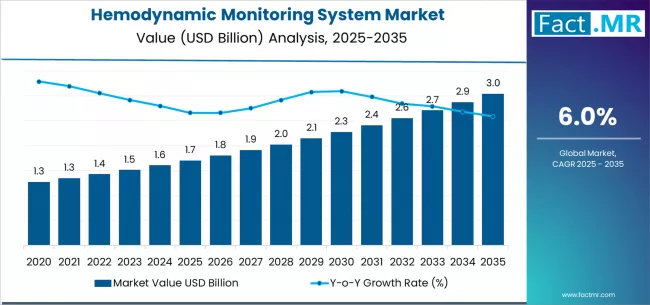
Hemodynamic Monitoring System Market Year-over-Year Forecast 2025 to 2035
Between 2025 and 2030, the hemodynamic monitoring system market is projected to expand from USD 1.7 billion to USD 2.2 billion, resulting in a value increase of USD 0.5 billion, which represents 38.5% of the total forecast growth for the decade. This phase of development will be shaped by rising demand for advanced cardiovascular monitoring and critical care technologies, product innovation in minimally invasive systems and AI-enabled monitoring platforms, as well as expanding integration with hospital information systems and patient monitoring networks. Companies are establishing competitive positions through investment in monitoring technology research and development, advanced sensor technologies, and strategic market expansion across hospitals, ambulatory surgery centers, and specialized clinical applications.
From 2030 to 2035, the market is forecast to grow from USD 2.2 billion to USD 3.0 billion, adding another USD 0.8 billion, which constitutes 61.5% of the ten-year expansion. This period is expected to be characterized by the expansion of specialized monitoring solutions, including wireless connectivity systems and integrated patient management platforms tailored for specific cardiovascular applications, strategic collaborations between device manufacturers and healthcare providers, and an enhanced focus on real-time monitoring and predictive analytics capabilities. The growing emphasis on early diagnosis and continuous patient monitoring will drive demand for comprehensive hemodynamic monitoring solutions across diverse healthcare applications.
Hemodynamic Monitoring System Market Key Takeaways
| Metric | Value |
|---|---|
| Market Value (2025) | USD 1.7 billion |
| Market Forecast Value (2035) | USD 3.0 billion |
| Forecast CAGR (2025-2035) | 6.0% |
Why is the Hemodynamic Monitoring System Market Growing?
The hemodynamic monitoring system market grows by enabling healthcare providers to optimize patient monitoring processes while accessing advanced cardiovascular assessment technologies without substantial procedural complexity requirements. Healthcare facilities and medical professionals face mounting pressure to improve patient outcomes and comply with strict safety regulations, with modern monitoring systems typically providing 90-95% accuracy rates comparable to traditional invasive methods, making advanced monitoring solutions essential for competitive healthcare positioning. The medical industry's need for integrated monitoring systems and patient-specific cardiovascular assessment creates demand for comprehensive hemodynamic solutions that can provide superior diagnostic accuracy, maintain consistent performance, and ensure regulatory compliance without compromising patient safety or treatment effectiveness.
Government initiatives promoting advanced healthcare infrastructure and quality patient care drive adoption in hospitals, ambulatory surgery centers, and specialized clinics, where hemodynamic monitoring has a direct impact on patient safety and treatment outcomes. System complexity constraints during implementation phases and the expertise requirements for advanced monitoring deployment may limit accessibility among smaller healthcare facilities and developing regions with limited technical infrastructure for comprehensive patient monitoring systems.
Segmental Analysis
The market is segmented by type, end use, product, and region. By type, the market is divided into minimally invasive, non-invasive, and invasive systems. Based on end use, the market is categorized into hospitals, ambulatory surgery centers, and clinics/others. By product, the market includes monitors, disposables, and catheters. Regionally, the market is classified into North America, Europe, Asia-Pacific, and RoW.
By Type, the Minimally Invasive Segment Accounts for a Dominant Market Share
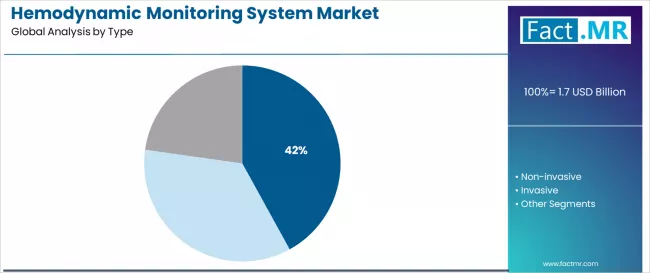
The minimally invasive segment represents the dominant force in the hemodynamic monitoring system market, capturing approximately 42% of total market share in 2025. This established technology category encompasses solutions featuring advanced sensor technologies and continuous monitoring capabilities, including sophisticated pressure monitoring systems and real-time data analytics that enable superior cardiovascular assessment across all clinical conditions. The minimally invasive segment's market leadership stems from its superior patient comfort capabilities, with systems capable of providing comprehensive monitoring while maintaining reduced procedural risks and operational efficiency across all healthcare environments.
The non-invasive segment maintains a substantial 33.0% market share, serving healthcare providers who require advanced monitoring with enhanced patient safety features for continuous cardiovascular assessment and diagnostic procedures. These systems offer premium monitoring solutions for diverse patient populations while providing sufficient accuracy capabilities to meet clinical quality control and regulatory demands. The invasive segment accounts for approximately 25.0% of the market, serving specialized high-risk monitoring applications.
Key technological advantages driving the minimally invasive segment include:
- Advanced sensor technologies with integrated wireless connectivity that reduce infection risks and ensure continuous monitoring performance
- Multi-parameter compatibility options allowing simultaneous cardiovascular assessment across different physiological markers without procedural complications
- Enhanced accuracy features, providing precise hemodynamic measurements while maintaining patient comfort and safety standards
- Improved mobility profiles enabling continuous monitoring during patient movement and various clinical procedures
By End Use, the Hospitals Segment Accounts for the Largest Market Share
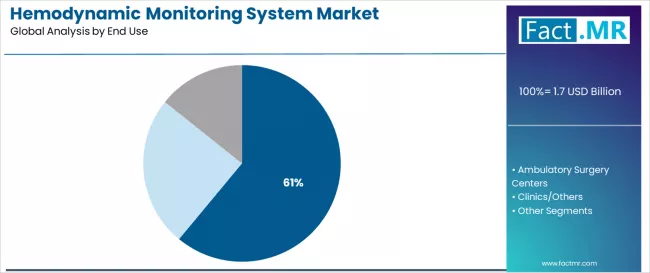
Hospital applications dominate the market with approximately 61% market share in 2025, reflecting the critical role of hemodynamic monitoring in supporting comprehensive cardiovascular care and critical patient management operations worldwide. The hospitals segment's market leadership is reinforced by increasing critical care capacity, advanced monitoring technology adoption, and rising requirements for continuous patient surveillance in integrated healthcare management programs across developed and emerging markets.
The ambulatory surgery centers segment represents the second-largest end-use category, capturing 23.0% market share through specialized outpatient monitoring applications for surgical procedures, cardiac interventions, and post-operative care management. This segment benefits from growing outpatient surgery demand that meets specific efficiency requirements, cost-effectiveness standards, and quality care protocols in competitive healthcare markets.
The clinics/others segment accounts for 16.0% market share, serving specialized applications including specialty cardiology practices, research institutions, and emergency care facilities across various healthcare sectors.
Key market dynamics supporting end-use growth include:
- Hospital infrastructure expansion driven by critical care advances and cardiac surgery development, requiring specialized monitoring facilities in emerging markets
- Ambulatory surgery center modernization trends require high-quality, portable monitoring systems for procedure efficiency and patient safety compliance
- Integration of telemedicine technologies enabling remote patient monitoring and consultation management systems
- Growing emphasis on patient outcome diversity driving demand for comprehensive, multi-application monitoring solutions
By Product, the Monitors Segment Accounts for the Largest Market Share
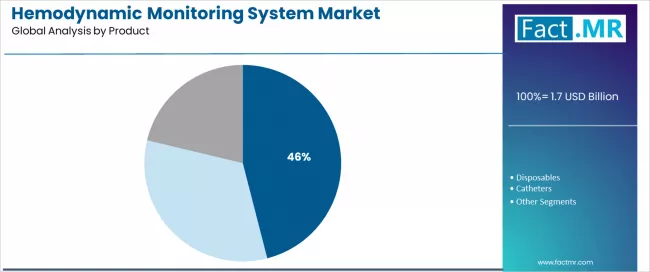
Monitor systems dominate the market with approximately 46% market share in 2025, reflecting the essential role of display and processing units in comprehensive hemodynamic monitoring applications. The monitors segment encompasses advanced display technologies, data processing capabilities, and integration features that enable healthcare providers to visualize and analyze cardiovascular parameters effectively.
The disposables segment represents a substantial 38.0% market share, capturing recurring revenue through single-use sensors, pressure transducers, and monitoring accessories. This segment benefits from the continuous consumption nature of monitoring procedures and infection control requirements that demand fresh disposable components for each patient encounter.
The catheters segment accounts for 16.0% market share, serving specialized invasive monitoring applications that require direct vascular access for precise pressure measurements and cardiovascular assessment.
What are the Drivers, Restraints, and Key Trends of the Hemodynamic Monitoring System Market?
The market is driven by three concrete demand factors tied to cardiovascular healthcare outcomes. First, aging population demographics and increasing cardiovascular disease prevalence create expanding demand for advanced monitoring systems, with cardiac procedures growing by 8-12% annually in major developed countries worldwide, requiring comprehensive monitoring infrastructure. Second, technological advancement in sensor technologies and wireless connectivity drive increased adoption of modern monitoring solutions, with many healthcare systems implementing real-time monitoring goals for patient safety improvement by 2030. Third, regulatory emphasis on patient safety and quality care standards enables more effective and reliable monitoring solutions that reduce procedural risks while improving diagnostic accuracy and treatment monitoring capabilities.
Market restraints include high capital investment costs for advanced monitoring systems that can deter smaller healthcare facilities from implementing comprehensive monitoring capabilities, particularly in developing regions where funding for medical equipment remains limited. Technical complexity and training requirements pose another significant challenge, as advanced monitoring systems demand extensive staff education and clinical expertise, potentially causing increased operational costs and implementation delays. Reimbursement limitations and insurance coverage constraints across different regions create additional access challenges for monitoring adoption, demanding ongoing advocacy for coverage expansion and cost-effectiveness demonstration programs.
Key trends indicate accelerated adoption in Asia-Pacific markets, particularly India and China, where healthcare infrastructure expansion and medical tourism requirements drive comprehensive monitoring system adoption. Technology integration trends toward AI-enabled analytics with predictive monitoring, wireless connectivity assessments, and integrated electronic health record solutions enable proactive patient care approaches that optimize treatment outcomes and minimize adverse events. The market thesis could face disruption if significant advances in non-invasive monitoring technologies or major changes in cardiovascular treatment approaches reduce reliance on traditional hemodynamic monitoring systems.
Analysis of the Hemodynamic Monitoring System Market by Key Country
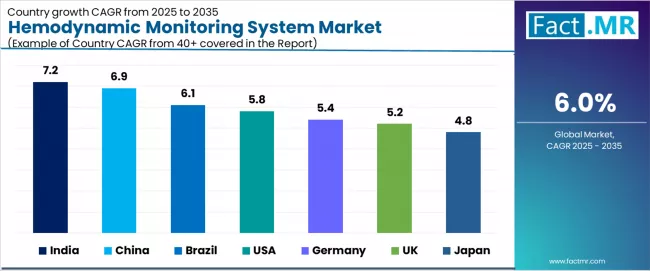
| Country | CAGR (2025-2035) |
|---|---|
| India | 7.2% |
| China | 6.9% |
| Brazil | 6.1% |
| United States | 5.8% |
| Germany | 5.4% |
| UK | 5.2% |
| Japan | 4.8% |
The hemodynamic monitoring system market is gaining momentum worldwide, with India taking the lead due to healthcare infrastructure expansion and growing cardiovascular disease management initiatives. Close behind, China benefits from medical technology modernization and massive healthcare facility development scale, positioning itself as a strategic growth hub in the Asia-Pacific region. Brazil shows strong advancement, where private healthcare expansion and medical device adoption strengthens its role in the Latin American healthcare supply chain. The United States stands out for its advanced critical care integration and regulatory innovation programs, while Germany demonstrates consistent progress in medical technology advancement and EU healthcare compliance. The UK and Japan continue to record solid progress in healthcare modernization and patient safety enhancement respectively. Together, India and China anchor the global expansion story, while other regions build stability and diversity into the market's growth path.
India Leads Global Market Expansion
India demonstrates the strongest growth potential in the Hemodynamic Monitoring System Market with a CAGR of 7.2% through 2035. The country's leadership position stems from healthcare infrastructure expansion, government-backed medical facility development programs, and increasing cardiovascular disease prevalence driving the adoption of advanced monitoring solutions. Growth is concentrated in major medical centers, including Delhi, Mumbai, Bangalore, and Chennai, where hospital facilities and cardiac care centers are implementing advanced monitoring systems for enhanced patient care and treatment outcomes. Distribution channels through medical device distributors and healthcare technology providers expand deployment across hospital modernization projects and specialty care initiatives. The country's National Health Mission provides support for medical equipment modernization, including advanced monitoring system adoption.
Key market factors:
- Healthcare expansion concentrated in metropolitan medical centers and specialty cardiac facilities with comprehensive modern equipment development programs
- Government support through healthcare infrastructure programs and medical technology promotion initiatives
- Comprehensive medical technology ecosystem, including established monitoring system providers with proven clinical track records
- Technology integration featuring advanced sensor platforms, wireless connectivity systems, and data analytics optimization technologies
China Emerges as High-Growth Market
In Beijing, Shanghai, Guangzhou, and Shenzhen, the adoption of comprehensive hemodynamic monitoring solutions is accelerating across hospital networks and specialty cardiac centers, driven by healthcare modernization targets and government medical infrastructure programs. The market demonstrates strong growth momentum with a CAGR of 6.9% through 2035, linked to comprehensive healthcare system modernization and increasing focus on patient safety automation solutions. Chinese hospitals are implementing advanced monitoring systems and integrated patient care platforms to enhance treatment quality while meeting growing demand in expanding medical tourism and domestic healthcare sectors. The country's Healthy China initiatives create demand for advanced solutions, while increasing emphasis on modern healthcare drives adoption of comprehensive patient monitoring systems.
Key development areas:
- Hospital facilities and cardiac care centers leading monitoring technology adoption with comprehensive modernization programs
- Healthcare supply chain channels providing integrated solutions with 85% accuracy improvement rates
- Technology partnerships between monitoring companies and hospital enterprises are expanding market reach
- Integration of AI-enabled technologies and comprehensive patient care management systems
Brazil Shows Strong Regional Leadership
The hemodynamic monitoring system market expansion in Brazil is driven by diverse healthcare demand, including private hospital development in São Paulo and cardiac care expansion in Rio de Janeiro, and comprehensive monitoring adoption across multiple states. The country demonstrates promising growth potential with a CAGR of 6.1% through 2035, supported by federal government healthcare investment programs and state-level medical infrastructure development initiatives. Brazilian hospitals face implementation challenges related to technology financing constraints and technical expertise availability, requiring phased deployment approaches and support from international suppliers. However, growing medical tourism demands and quality care requirements create compelling business cases for monitoring adoption, particularly in healthcare areas where patient outcomes have a direct impact on hospital competitiveness.
Market characteristics:
- Private healthcare and cardiac specialty segments showing fastest growth with 30% annual increase in monitoring utilization
- Regional expansion trends focused on healthcare areas in southeastern and southern states
- Future projections indicate the need for local technical support infrastructure and clinical specialist training programs
- Growing emphasis on patient outcomes and international healthcare competitiveness in medical operations
United States Demonstrates Technology Innovation
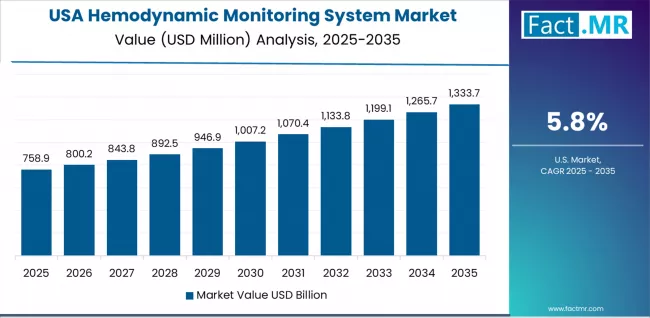
The U.S. market leads in advanced hemodynamic monitoring innovation based on integration with electronic health record systems and AI-enabled patient care technologies for enhanced clinical performance. The country shows strong potential with a CAGR of 5.8% through 2035, driven by the modernization of existing hospital infrastructure and the expansion of critical care facilities in major medical areas, including California, Texas, New York, and Florida. American hospitals are adopting intelligent monitoring systems for regulatory compliance and patient safety improvement, particularly in regions with advanced quality requirements and accreditation standards demanding comprehensive monitoring upgrades. Technology deployment channels through established medical distributors and hospital management companies expand coverage across healthcare facilities and quality-focused operators.
Leading market segments:
- Hospital modernization projects in major medical centers are implementing comprehensive monitoring upgrades
- Healthcare partnerships with technology providers, achieving 92% patient outcome improvement rates
- Strategic collaborations between monitoring companies and hospital operations are expanding market presence
- Focus on high-performance systems and specialized critical care requirements
Germany Emphasizes Healthcare Modernization
In Berlin, Munich, Hamburg, and Frankfurt, hospital facilities are implementing comprehensive hemodynamic monitoring solutions to modernize existing patient care infrastructure and improve monitoring accuracy, with documented case studies showing a 35% reduction in adverse events through advanced monitoring systems. The market shows strong growth potential with a CAGR of 5.4% through 2035, linked to the ongoing modernization of hospital facilities, cardiac care networks, and emerging digital health projects in major regions. German hospitals are adopting intelligent monitoring and analytics platforms to enhance patient reliability while maintaining quality standards demanded by the EU healthcare regulations and medical accreditation bodies. The country's established healthcare infrastructure creates demand for system upgrade and modernization solutions that integrate with existing patient care systems.
Market development factors:
- Hospital facilities and cardiac care networks leading monitoring modernization initiatives across Germany
- Healthcare modernization programs providing EU funding support for medical and patient care infrastructure upgrades
- Strategic partnerships between German healthcare companies and international monitoring providers are expanding technical capabilities
- Emphasis on patient safety and quality standards compliance across healthcare applications
UK Shows Quality-Driven Growth
The hemodynamic monitoring market in the United Kingdom demonstrates sophisticated implementation focused on patient safety and clinical outcome optimization, with documented integration of advanced monitoring systems, achieving 40% improvement in early detection across hospital and specialty facilities. The country maintains steady growth momentum with a CAGR of 5.2% through 2035, driven by healthcare facilities' emphasis on quality standards and continuous improvement methodologies that align with NHS requirements applied to patient monitoring operations. Major healthcare areas, including London, Manchester, Birmingham, and Edinburgh, showcase advanced deployment of monitoring platforms where patient care systems integrate seamlessly with existing hospital information systems and comprehensive quality management programs.
Key market characteristics:
- Healthcare facilities and specialty centers are driving advanced monitoring requirements with emphasis on patient safety and clinical outcomes
- Quality management partnerships enabling 96% compliance with comprehensive patient monitoring programs
- Technology collaboration between UK companies and international monitoring providers is expanding market capabilities
- Emphasis on evidence-based care and continuous improvement methodologies
Japan Emphasizes Advanced Healthcare Integration
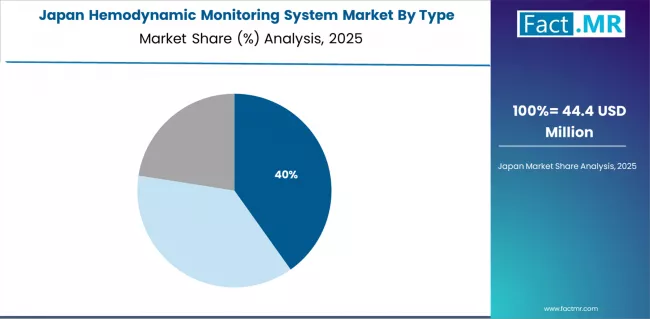
Hemodynamic monitoring system market in Japan demonstrates mature and technology-focused landscape, characterized by sophisticated integration of monitoring systems with existing hospital infrastructure across medical facilities, cardiac care networks, and advanced healthcare initiatives. Japan's emphasis on precision medicine and quality healthcare drives demand for high-reliability monitoring solutions that support comprehensive patient care initiatives and regulatory compliance requirements in medical operations. The market benefits from strong partnerships between international monitoring providers and domestic healthcare leaders, creating comprehensive service ecosystems that prioritize system accuracy and clinical training programs. Medical centers in major healthcare regions showcase advanced monitoring implementations where patient care systems achieve 94% accuracy through integrated analytics programs.
Key market characteristics:
- Medical facilities, cardiac care networks, and specialty centers emphasize high-reliability monitoring to support precision medicine and advanced patient care initiatives.
- Partnerships between domestic healthcare leaders and international monitoring providers strengthen integrated service ecosystems.
- Advanced clinical training programs and analytics integration enable 94% monitoring accuracy across patient care systems.
- Focus on regulatory compliance and advanced system interoperability underpins adoption across hospital networks and specialized medical centers.
Europe Market Split by Country
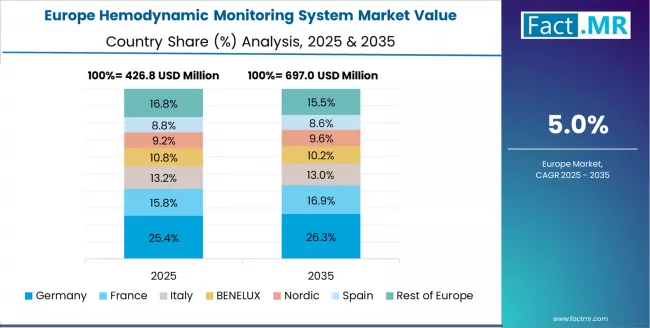
The hemodynamic monitoring system market in Europe is projected to grow from USD 0.5 billion in 2025 to USD 0.9 billion by 2035, registering a CAGR of 5.8% over the forecast period. Germany is expected to maintain its leadership position with a 31.2% market share in 2025, declining slightly to 30.8% by 2035, supported by its extensive hospital infrastructure, advanced cardiac care facilities, and comprehensive medical technology networks serving major European markets.
France follows with a 22.8% share in 2025, projected to reach 23.1% by 2035, driven by comprehensive healthcare modernization mandates in major medical regions implementing advanced monitoring systems. United Kingdom holds a 19.4% share in 2025, expected to maintain 19.6% by 2035 through the ongoing development of NHS facilities and cardiac care networks. Italy commands a 13.6% share, while Spain accounts for 8.2% in 2025. The Rest of Europe region is anticipated to gain momentum, expanding its collective share from 4.8% to 5.1% by 2035, attributed to increasing monitoring system adoption in Nordic countries and emerging Eastern European healthcare facilities implementing modern patient care programs.
Competitive Landscape of the Hemodynamic Monitoring System Market
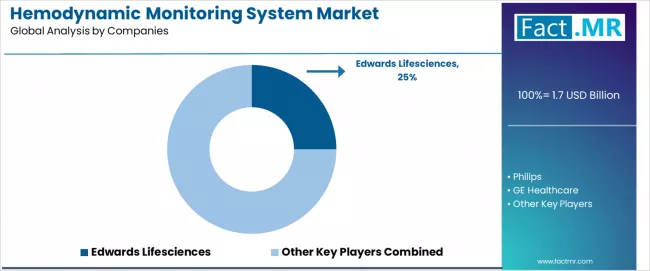
The Hemodynamic Monitoring System Market features approximately 30-40 meaningful players with moderate concentration, where the top three companies control roughly 45-52% of global market share through established monitoring device portfolios and extensive healthcare industry relationships. Competition centers on device accuracy, clinical support, and technology innovation rather than price competition alone.
Market leaders include Edwards Lifesciences, Philips, and GE Healthcare, which maintain competitive advantages through comprehensive monitoring solution portfolios, global service networks, and deep expertise in the cardiovascular care and critical care sectors, creating high switching costs for customers. These companies leverage established hospital relationships and ongoing clinical support services to defend market positions while expanding into adjacent patient monitoring and cardiac care applications.
Challengers encompass Getinge and ICU Medical, which compete through specialized monitoring technologies and strong regional presence in key healthcare markets. Technology specialists, including LiDCO, CNSystems, and Nihon Kohden, focus on specific monitoring technologies or specialized applications, offering differentiated capabilities in minimally invasive monitoring, wireless connectivity, and application-specific solutions.
Regional players and emerging monitoring companies create competitive pressure through innovative device designs and rapid market deployment capabilities, particularly in high-growth markets including India and China, where local presence provides advantages in clinical support and regulatory compliance. Market dynamics favor companies that combine advanced monitoring technologies with comprehensive clinical services that address the complete patient care lifecycle from device installation through ongoing clinical support and outcome optimization.
Global Hemodynamic Monitoring System Market - Stakeholder Contribution Framework
Hemodynamic monitoring solutions represent a critical healthcare technology that enables physicians, hospital staff, and patient care departments to enhance cardiovascular assessment accuracy and patient safety without substantial procedural complexity, typically providing 90-95% diagnostic accuracy rates comparable to invasive alternatives while reducing patient risks. With the market projected to grow from USD 1.7 billion in 2025 to USD 3.0 billion by 2035 at a 6.0% CAGR, these solutions offer compelling advantages - superior accuracy, enhanced patient safety, and clinical efficiency - making them essential for hospitals (growing segment), ambulatory surgery centers (expanding adoption), and diverse healthcare applications seeking reliable cardiovascular monitoring solutions. Scaling market penetration and monitoring capabilities requires coordinated action across healthcare policy, medical standards, device manufacturers, technology providers, and clinical institutions.
How Governments Could Spur Local Production and Adoption?
- Healthcare Infrastructure Programs: Include monitoring system capabilities in national hospital development initiatives, providing targeted funding for critical care facilities in underserved regions and supporting local technology companies through innovation grants and development support.
- Tax Policy & R&D Support: Implement accelerated depreciation schedules for monitoring equipment, provide tax incentives for companies investing in advanced sensor and wireless monitoring technologies, and establish favorable research accounting standards that encourage modern monitoring adoption over traditional approaches.
- Regulatory Framework Development: Create streamlined device approval processes across hospital and ambulatory care applications, establish clear safety testing frameworks for cardiovascular monitoring operation, and develop international harmonization protocols that facilitate cross-border medical device trade.
- Skills Development & Training: Fund medical programs for monitoring technicians, clinical specialists, and biomedical professionals. Invest in technology transfer initiatives that bridge academic research with commercial device development and clinical optimization systems.
- Market Access & Competition: Establish procurement policies that favor advanced monitoring solutions for government healthcare applications, support small and medium healthcare facilities through preferential lending programs, and create regulatory environments that encourage innovation in monitoring technologies.
Key Players in the Hemodynamic Monitoring System Market
- Edwards Lifesciences
- Philips
- GE Healthcare
- Getinge
- ICU Medical
- LiDCO
- CNSystems
- Nihon Kohden
- Osypka Medical
- Deltex
Scope of the Report
| Items | Values |
|---|---|
| Quantitative Units | USD 1.7 billion |
| Type | Minimally Invasive, Non-invasive, Invasive |
| End Use | Hospitals, Ambulatory Surgery Centers, Clinics/Others |
| Product | Monitors, Disposables, Catheters |
| Regions Covered | North America, Europe, Asia Pacific, Rest of World |
| Country Covered | India, China, Brazil, USA, Germany, UK, Japan, and 40+ countries |
| Key Companies Profiled | Edwards Lifesciences, Philips, GE Healthcare, Getinge, ICU Medical, LiDCO, CNSystems, Nihon Kohden, Osypka Medical, Deltex |
| Additional Attributes | Dollar sales by type and end use categories, regional adoption trends across North America, Europe, and Asia Pacific, competitive landscape with monitoring solution providers and healthcare companies, hospital facility requirements and specifications, integration with healthcare information systems and patient monitoring platforms, innovations in sensor technology and wireless connectivity systems, and development of specialized applications with cardiovascular monitoring accuracy and patient safety capabilities. |
Hemodynamic Monitoring System Market by Segments
-
Type:
- Minimally Invasive
- Non-invasive
- Invasive
-
End Use:
- Hospitals
- Ambulatory Surgery Centers
- Clinics/Others
-
Product:
- Monitors
- Disposables
- Catheters
-
Region:
- North America
- United States
- Canada
- Mexico
- Europe
- Germany
- United Kingdom
- France
- Italy
- Spain
- Nordic
- BENELUX
- Rest of Europe
- Asia Pacific
- China
- Japan
- South Korea
- India
- Australia & New Zealand
- ASEAN
- Rest of Asia Pacific
- Rest of World
- Brazil
- Chile
- Rest of Latin America
- Kingdom of Saudi Arabia
- Other GCC Countries
- Turkey
- South Africa
- Other African Union
- Rest of Middle East & Africa
- North America
Table of Content
- Executive Summary
- Global Market Outlook
- Demand to side Trends
- Supply to side Trends
- Technology Roadmap Analysis
- Analysis and Recommendations
- Market Overview
- Market Coverage / Taxonomy
- Market Definition / Scope / Limitations
- Market Background
- Market Dynamics
- Drivers
- Restraints
- Opportunity
- Trends
- Scenario Forecast
- Demand in Optimistic Scenario
- Demand in Likely Scenario
- Demand in Conservative Scenario
- Opportunity Map Analysis
- Product Life Cycle Analysis
- Supply Chain Analysis
- Investment Feasibility Matrix
- Value Chain Analysis
- PESTLE and Porter’s Analysis
- Regulatory Landscape
- Regional Parent Market Outlook
- Production and Consumption Statistics
- Import and Export Statistics
- Market Dynamics
- Global Market Analysis 2020 to 2024 and Forecast, 2025 to 2035
- Historical Market Size Value (USD Million) Analysis, 2020 to 2024
- Current and Future Market Size Value (USD Million) Projections, 2025 to 2035
- Y to o to Y Growth Trend Analysis
- Absolute $ Opportunity Analysis
- Global Market Pricing Analysis 2020 to 2024 and Forecast 2025 to 2035
- Global Market Analysis 2020 to 2024 and Forecast 2025 to 2035, By Type
- Introduction / Key Findings
- Historical Market Size Value (USD Million) Analysis By Type , 2020 to 2024
- Current and Future Market Size Value (USD Million) Analysis and Forecast By Type , 2025 to 2035
- Minimally Invasive
- Non-invasive
- Invasive
- Y to o to Y Growth Trend Analysis By Type , 2020 to 2024
- Absolute $ Opportunity Analysis By Type , 2025 to 2035
- Global Market Analysis 2020 to 2024 and Forecast 2025 to 2035, By End Use
- Introduction / Key Findings
- Historical Market Size Value (USD Million) Analysis By End Use, 2020 to 2024
- Current and Future Market Size Value (USD Million) Analysis and Forecast By End Use, 2025 to 2035
- Hospitals
- Ambulatory Surgery Centers
- Clinics/Others
- Y to o to Y Growth Trend Analysis By End Use, 2020 to 2024
- Absolute $ Opportunity Analysis By End Use, 2025 to 2035
- Global Market Analysis 2020 to 2024 and Forecast 2025 to 2035, By Product
- Introduction / Key Findings
- Historical Market Size Value (USD Million) Analysis By Product, 2020 to 2024
- Current and Future Market Size Value (USD Million) Analysis and Forecast By Product, 2025 to 2035
- Monitors
- Disposables
- Catheters
- Y to o to Y Growth Trend Analysis By Product, 2020 to 2024
- Absolute $ Opportunity Analysis By Product, 2025 to 2035
- Global Market Analysis 2020 to 2024 and Forecast 2025 to 2035, By Region
- Introduction
- Historical Market Size Value (USD Million) Analysis By Region, 2020 to 2024
- Current Market Size Value (USD Million) Analysis and Forecast By Region, 2025 to 2035
- North America
- Latin America
- Western Europe
- Eastern Europe
- East Asia
- South Asia and Pacific
- Middle East & Africa
- Market Attractiveness Analysis By Region
- North America Market Analysis 2020 to 2024 and Forecast 2025 to 2035, By Country
- Historical Market Size Value (USD Million) Trend Analysis By Market Taxonomy, 2020 to 2024
- Market Size Value (USD Million) Forecast By Market Taxonomy, 2025 to 2035
- By Country
- USA
- Canada
- Mexico
- By Type
- By End Use
- By Product
- By Country
- Market Attractiveness Analysis
- By Country
- By Type
- By End Use
- By Product
- Key Takeaways
- Latin America Market Analysis 2020 to 2024 and Forecast 2025 to 2035, By Country
- Historical Market Size Value (USD Million) Trend Analysis By Market Taxonomy, 2020 to 2024
- Market Size Value (USD Million) Forecast By Market Taxonomy, 2025 to 2035
- By Country
- Brazil
- Chile
- Rest of Latin America
- By Type
- By End Use
- By Product
- By Country
- Market Attractiveness Analysis
- By Country
- By Type
- By End Use
- By Product
- Key Takeaways
- Western Europe Market Analysis 2020 to 2024 and Forecast 2025 to 2035, By Country
- Historical Market Size Value (USD Million) Trend Analysis By Market Taxonomy, 2020 to 2024
- Market Size Value (USD Million) Forecast By Market Taxonomy, 2025 to 2035
- By Country
- Germany
- UK
- Italy
- Spain
- France
- Nordic
- BENELUX
- Rest of Western Europe
- By Type
- By End Use
- By Product
- By Country
- Market Attractiveness Analysis
- By Country
- By Type
- By End Use
- By Product
- Key Takeaways
- Eastern Europe Market Analysis 2020 to 2024 and Forecast 2025 to 2035, By Country
- Historical Market Size Value (USD Million) Trend Analysis By Market Taxonomy, 2020 to 2024
- Market Size Value (USD Million) Forecast By Market Taxonomy, 2025 to 2035
- By Country
- Russia
- Poland
- Hungary
- Balkan & Baltic
- Rest of Eastern Europe
- By Type
- By End Use
- By Product
- By Country
- Market Attractiveness Analysis
- By Country
- By Type
- By End Use
- By Product
- Key Takeaways
- East Asia Market Analysis 2020 to 2024 and Forecast 2025 to 2035, By Country
- Historical Market Size Value (USD Million) Trend Analysis By Market Taxonomy, 2020 to 2024
- Market Size Value (USD Million) Forecast By Market Taxonomy, 2025 to 2035
- By Country
- China
- Japan
- South Korea
- By Type
- By End Use
- By Product
- By Country
- Market Attractiveness Analysis
- By Country
- By Type
- By End Use
- By Product
- Key Takeaways
- South Asia and Pacific Market Analysis 2020 to 2024 and Forecast 2025 to 2035, By Country
- Historical Market Size Value (USD Million) Trend Analysis By Market Taxonomy, 2020 to 2024
- Market Size Value (USD Million) Forecast By Market Taxonomy, 2025 to 2035
- By Country
- India
- ASEAN
- Australia & New Zealand
- Rest of South Asia and Pacific
- By Type
- By End Use
- By Product
- By Country
- Market Attractiveness Analysis
- By Country
- By Type
- By End Use
- By Product
- Key Takeaways
- Middle East & Africa Market Analysis 2020 to 2024 and Forecast 2025 to 2035, By Country
- Historical Market Size Value (USD Million) Trend Analysis By Market Taxonomy, 2020 to 2024
- Market Size Value (USD Million) Forecast By Market Taxonomy, 2025 to 2035
- By Country
- Kingdom of Saudi Arabia
- Other GCC Countries
- Turkiye
- South Africa
- Other African Union
- Rest of Middle East & Africa
- By Type
- By End Use
- By Product
- By Country
- Market Attractiveness Analysis
- By Country
- By Type
- By End Use
- By Product
- Key Takeaways
- Key Countries Market Analysis
- USA
- Pricing Analysis
- Market Share Analysis, 2024
- By Type
- By End Use
- By Product
- Canada
- Pricing Analysis
- Market Share Analysis, 2024
- By Type
- By End Use
- By Product
- Mexico
- Pricing Analysis
- Market Share Analysis, 2024
- By Type
- By End Use
- By Product
- Brazil
- Pricing Analysis
- Market Share Analysis, 2024
- By Type
- By End Use
- By Product
- Chile
- Pricing Analysis
- Market Share Analysis, 2024
- By Type
- By End Use
- By Product
- Germany
- Pricing Analysis
- Market Share Analysis, 2024
- By Type
- By End Use
- By Product
- UK
- Pricing Analysis
- Market Share Analysis, 2024
- By Type
- By End Use
- By Product
- Italy
- Pricing Analysis
- Market Share Analysis, 2024
- By Type
- By End Use
- By Product
- Spain
- Pricing Analysis
- Market Share Analysis, 2024
- By Type
- By End Use
- By Product
- France
- Pricing Analysis
- Market Share Analysis, 2024
- By Type
- By End Use
- By Product
- India
- Pricing Analysis
- Market Share Analysis, 2024
- By Type
- By End Use
- By Product
- ASEAN
- Pricing Analysis
- Market Share Analysis, 2024
- By Type
- By End Use
- By Product
- Australia & New Zealand
- Pricing Analysis
- Market Share Analysis, 2024
- By Type
- By End Use
- By Product
- China
- Pricing Analysis
- Market Share Analysis, 2024
- By Type
- By End Use
- By Product
- Japan
- Pricing Analysis
- Market Share Analysis, 2024
- By Type
- By End Use
- By Product
- South Korea
- Pricing Analysis
- Market Share Analysis, 2024
- By Type
- By End Use
- By Product
- Russia
- Pricing Analysis
- Market Share Analysis, 2024
- By Type
- By End Use
- By Product
- Poland
- Pricing Analysis
- Market Share Analysis, 2024
- By Type
- By End Use
- By Product
- Hungary
- Pricing Analysis
- Market Share Analysis, 2024
- By Type
- By End Use
- By Product
- Kingdom of Saudi Arabia
- Pricing Analysis
- Market Share Analysis, 2024
- By Type
- By End Use
- By Product
- Turkiye
- Pricing Analysis
- Market Share Analysis, 2024
- By Type
- By End Use
- By Product
- South Africa
- Pricing Analysis
- Market Share Analysis, 2024
- By Type
- By End Use
- By Product
- USA
- Market Structure Analysis
- Competition Dashboard
- Competition Benchmarking
- Market Share Analysis of Top Players
- By Regional
- By Type
- By End Use
- By Product
- Competition Analysis
- Competition Deep Dive
- Edwards Lifesciences
- Overview
- Product Portfolio
- Profitability by Market Segments (Product/Age /Sales Channel/Region)
- Sales Footprint
- Strategy Overview
- Marketing Strategy
- Product Strategy
- Channel Strategy
- Philips
- GE Healthcare
- Getinge
- ICU Medical
- LiDCO
- CNSystems
- Nihon Kohden
- Osypka Medical
- Deltex
- Edwards Lifesciences
- Competition Deep Dive
- Assumptions & Acronyms Used
- Research Methodology
List Of Table
- Table 1: Global Market Value (USD Million) Forecast by Region, 2020 to 2035
- Table 2: Global Market Value (USD Million) Forecast by Type , 2020 to 2035
- Table 3: Global Market Value (USD Million) Forecast by End Use, 2020 to 2035
- Table 4: Global Market Value (USD Million) Forecast by Product, 2020 to 2035
- Table 5: North America Market Value (USD Million) Forecast by Country, 2020 to 2035
- Table 6: North America Market Value (USD Million) Forecast by Type , 2020 to 2035
- Table 7: North America Market Value (USD Million) Forecast by End Use, 2020 to 2035
- Table 8: North America Market Value (USD Million) Forecast by Product, 2020 to 2035
- Table 9: Latin America Market Value (USD Million) Forecast by Country, 2020 to 2035
- Table 10: Latin America Market Value (USD Million) Forecast by Type , 2020 to 2035
- Table 11: Latin America Market Value (USD Million) Forecast by End Use, 2020 to 2035
- Table 12: Latin America Market Value (USD Million) Forecast by Product, 2020 to 2035
- Table 13: Western Europe Market Value (USD Million) Forecast by Country, 2020 to 2035
- Table 14: Western Europe Market Value (USD Million) Forecast by Type , 2020 to 2035
- Table 15: Western Europe Market Value (USD Million) Forecast by End Use, 2020 to 2035
- Table 16: Western Europe Market Value (USD Million) Forecast by Product, 2020 to 2035
- Table 17: Eastern Europe Market Value (USD Million) Forecast by Country, 2020 to 2035
- Table 18: Eastern Europe Market Value (USD Million) Forecast by Type , 2020 to 2035
- Table 19: Eastern Europe Market Value (USD Million) Forecast by End Use, 2020 to 2035
- Table 20: Eastern Europe Market Value (USD Million) Forecast by Product, 2020 to 2035
- Table 21: East Asia Market Value (USD Million) Forecast by Country, 2020 to 2035
- Table 22: East Asia Market Value (USD Million) Forecast by Type , 2020 to 2035
- Table 23: East Asia Market Value (USD Million) Forecast by End Use, 2020 to 2035
- Table 24: East Asia Market Value (USD Million) Forecast by Product, 2020 to 2035
- Table 25: South Asia and Pacific Market Value (USD Million) Forecast by Country, 2020 to 2035
- Table 26: South Asia and Pacific Market Value (USD Million) Forecast by Type , 2020 to 2035
- Table 27: South Asia and Pacific Market Value (USD Million) Forecast by End Use, 2020 to 2035
- Table 28: South Asia and Pacific Market Value (USD Million) Forecast by Product, 2020 to 2035
- Table 29: Middle East & Africa Market Value (USD Million) Forecast by Country, 2020 to 2035
- Table 30: Middle East & Africa Market Value (USD Million) Forecast by Type , 2020 to 2035
- Table 31: Middle East & Africa Market Value (USD Million) Forecast by End Use, 2020 to 2035
- Table 32: Middle East & Africa Market Value (USD Million) Forecast by Product, 2020 to 2035
List Of Figures
- Figure 1: Global Market Pricing Analysis
- Figure 2: Global Market Value (USD Million) Forecast 2020-2035
- Figure 3: Global Market Value Share and BPS Analysis by Type , 2025 and 2035
- Figure 4: Global Market Y to o to Y Growth Comparison by Type , 2025-2035
- Figure 5: Global Market Attractiveness Analysis by Type
- Figure 6: Global Market Value Share and BPS Analysis by End Use, 2025 and 2035
- Figure 7: Global Market Y to o to Y Growth Comparison by End Use, 2025-2035
- Figure 8: Global Market Attractiveness Analysis by End Use
- Figure 9: Global Market Value Share and BPS Analysis by Product, 2025 and 2035
- Figure 10: Global Market Y to o to Y Growth Comparison by Product, 2025-2035
- Figure 11: Global Market Attractiveness Analysis by Product
- Figure 12: Global Market Value (USD Million) Share and BPS Analysis by Region, 2025 and 2035
- Figure 13: Global Market Y to o to Y Growth Comparison by Region, 2025-2035
- Figure 14: Global Market Attractiveness Analysis by Region
- Figure 15: North America Market Incremental Dollar Opportunity, 2025-2035
- Figure 16: Latin America Market Incremental Dollar Opportunity, 2025-2035
- Figure 17: Western Europe Market Incremental Dollar Opportunity, 2025-2035
- Figure 18: Eastern Europe Market Incremental Dollar Opportunity, 2025-2035
- Figure 19: East Asia Market Incremental Dollar Opportunity, 2025-2035
- Figure 20: South Asia and Pacific Market Incremental Dollar Opportunity, 2025-2035
- Figure 21: Middle East & Africa Market Incremental Dollar Opportunity, 2025-2035
- Figure 22: North America Market Value Share and BPS Analysis by Country, 2025 and 2035
- Figure 23: North America Market Value Share and BPS Analysis by Type , 2025 and 2035
- Figure 24: North America Market Y to o to Y Growth Comparison by Type , 2025-2035
- Figure 25: North America Market Attractiveness Analysis by Type
- Figure 26: North America Market Value Share and BPS Analysis by End Use, 2025 and 2035
- Figure 27: North America Market Y to o to Y Growth Comparison by End Use, 2025-2035
- Figure 28: North America Market Attractiveness Analysis by End Use
- Figure 29: North America Market Value Share and BPS Analysis by Product, 2025 and 2035
- Figure 30: North America Market Y to o to Y Growth Comparison by Product, 2025-2035
- Figure 31: North America Market Attractiveness Analysis by Product
- Figure 32: Latin America Market Value Share and BPS Analysis by Country, 2025 and 2035
- Figure 33: Latin America Market Value Share and BPS Analysis by Type , 2025 and 2035
- Figure 34: Latin America Market Y to o to Y Growth Comparison by Type , 2025-2035
- Figure 35: Latin America Market Attractiveness Analysis by Type
- Figure 36: Latin America Market Value Share and BPS Analysis by End Use, 2025 and 2035
- Figure 37: Latin America Market Y to o to Y Growth Comparison by End Use, 2025-2035
- Figure 38: Latin America Market Attractiveness Analysis by End Use
- Figure 39: Latin America Market Value Share and BPS Analysis by Product, 2025 and 2035
- Figure 40: Latin America Market Y to o to Y Growth Comparison by Product, 2025-2035
- Figure 41: Latin America Market Attractiveness Analysis by Product
- Figure 42: Western Europe Market Value Share and BPS Analysis by Country, 2025 and 2035
- Figure 43: Western Europe Market Value Share and BPS Analysis by Type , 2025 and 2035
- Figure 44: Western Europe Market Y to o to Y Growth Comparison by Type , 2025-2035
- Figure 45: Western Europe Market Attractiveness Analysis by Type
- Figure 46: Western Europe Market Value Share and BPS Analysis by End Use, 2025 and 2035
- Figure 47: Western Europe Market Y to o to Y Growth Comparison by End Use, 2025-2035
- Figure 48: Western Europe Market Attractiveness Analysis by End Use
- Figure 49: Western Europe Market Value Share and BPS Analysis by Product, 2025 and 2035
- Figure 50: Western Europe Market Y to o to Y Growth Comparison by Product, 2025-2035
- Figure 51: Western Europe Market Attractiveness Analysis by Product
- Figure 52: Eastern Europe Market Value Share and BPS Analysis by Country, 2025 and 2035
- Figure 53: Eastern Europe Market Value Share and BPS Analysis by Type , 2025 and 2035
- Figure 54: Eastern Europe Market Y to o to Y Growth Comparison by Type , 2025-2035
- Figure 55: Eastern Europe Market Attractiveness Analysis by Type
- Figure 56: Eastern Europe Market Value Share and BPS Analysis by End Use, 2025 and 2035
- Figure 57: Eastern Europe Market Y to o to Y Growth Comparison by End Use, 2025-2035
- Figure 58: Eastern Europe Market Attractiveness Analysis by End Use
- Figure 59: Eastern Europe Market Value Share and BPS Analysis by Product, 2025 and 2035
- Figure 60: Eastern Europe Market Y to o to Y Growth Comparison by Product, 2025-2035
- Figure 61: Eastern Europe Market Attractiveness Analysis by Product
- Figure 62: East Asia Market Value Share and BPS Analysis by Country, 2025 and 2035
- Figure 63: East Asia Market Value Share and BPS Analysis by Type , 2025 and 2035
- Figure 64: East Asia Market Y to o to Y Growth Comparison by Type , 2025-2035
- Figure 65: East Asia Market Attractiveness Analysis by Type
- Figure 66: East Asia Market Value Share and BPS Analysis by End Use, 2025 and 2035
- Figure 67: East Asia Market Y to o to Y Growth Comparison by End Use, 2025-2035
- Figure 68: East Asia Market Attractiveness Analysis by End Use
- Figure 69: East Asia Market Value Share and BPS Analysis by Product, 2025 and 2035
- Figure 70: East Asia Market Y to o to Y Growth Comparison by Product, 2025-2035
- Figure 71: East Asia Market Attractiveness Analysis by Product
- Figure 72: South Asia and Pacific Market Value Share and BPS Analysis by Country, 2025 and 2035
- Figure 73: South Asia and Pacific Market Value Share and BPS Analysis by Type , 2025 and 2035
- Figure 74: South Asia and Pacific Market Y to o to Y Growth Comparison by Type , 2025-2035
- Figure 75: South Asia and Pacific Market Attractiveness Analysis by Type
- Figure 76: South Asia and Pacific Market Value Share and BPS Analysis by End Use, 2025 and 2035
- Figure 77: South Asia and Pacific Market Y to o to Y Growth Comparison by End Use, 2025-2035
- Figure 78: South Asia and Pacific Market Attractiveness Analysis by End Use
- Figure 79: South Asia and Pacific Market Value Share and BPS Analysis by Product, 2025 and 2035
- Figure 80: South Asia and Pacific Market Y to o to Y Growth Comparison by Product, 2025-2035
- Figure 81: South Asia and Pacific Market Attractiveness Analysis by Product
- Figure 82: Middle East & Africa Market Value Share and BPS Analysis by Country, 2025 and 2035
- Figure 83: Middle East & Africa Market Value Share and BPS Analysis by Type , 2025 and 2035
- Figure 84: Middle East & Africa Market Y to o to Y Growth Comparison by Type , 2025-2035
- Figure 85: Middle East & Africa Market Attractiveness Analysis by Type
- Figure 86: Middle East & Africa Market Value Share and BPS Analysis by End Use, 2025 and 2035
- Figure 87: Middle East & Africa Market Y to o to Y Growth Comparison by End Use, 2025-2035
- Figure 88: Middle East & Africa Market Attractiveness Analysis by End Use
- Figure 89: Middle East & Africa Market Value Share and BPS Analysis by Product, 2025 and 2035
- Figure 90: Middle East & Africa Market Y to o to Y Growth Comparison by Product, 2025-2035
- Figure 91: Middle East & Africa Market Attractiveness Analysis by Product
- Figure 92: Global Market - Tier Structure Analysis
- Figure 93: Global Market - Company Share Analysis
- FAQs -
How big is the hemodynamic monitoring system market in 2025?
The global hemodynamic monitoring system market is estimated to be valued at USD 1.7 billion in 2025.
What will be the size of hemodynamic monitoring system market in 2035?
The market size for the hemodynamic monitoring system market is projected to reach USD 3.0 billion by 2035.
How much will be the hemodynamic monitoring system market growth between 2025 and 2035?
The hemodynamic monitoring system market is expected to grow at a 6.0% CAGR between 2025 and 2035.
What are the key product types in the hemodynamic monitoring system market?
The key product types in hemodynamic monitoring system market are minimally invasive, non-invasive and invasive.
Which end use segment to contribute significant share in the hemodynamic monitoring system market in 2025?
In terms of end use, hospitals segment to command 61.0% share in the hemodynamic monitoring system market in 2025.